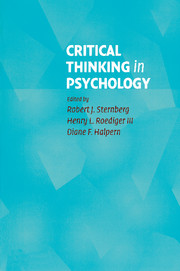Book contents
- Frontmatter
- Contents
- List of Illustrations and Tables
- List of Contributors
- Preface
- 1 The Nature and Nurture of Critical Thinking
- 2 Evaluating Experimental Research
- 3 Critical Thinking in Quasi-Experimentation
- 4 Evaluating Surveys and Questionnaires
- 5 Critical Thinking in Designing and Analyzing Research
- 6 The Case Study Perspective on Psychological Research
- 7 Informal Logical Fallacies
- 8 Designing Studies to Avoid Confounds
- 9 Evaluating Theories
- 10 Not All Experiments Are Created Equal
- 11 Making Claims in Papers and Talks
- 12 Critical Thinking in Clinical Inference
- 13 Evaluating Parapsychological Claims
- 14 Why Would Anyone Do or Believe Such a Thing?
- 15 The Belief Machine
- 16 Critical Thinking and Ethics in Psychology
- 17 Critical Thinking in Psychology
- Author Index
- Subject Index
- References
12 - Critical Thinking in Clinical Inference
Published online by Cambridge University Press: 05 June 2012
- Frontmatter
- Contents
- List of Illustrations and Tables
- List of Contributors
- Preface
- 1 The Nature and Nurture of Critical Thinking
- 2 Evaluating Experimental Research
- 3 Critical Thinking in Quasi-Experimentation
- 4 Evaluating Surveys and Questionnaires
- 5 Critical Thinking in Designing and Analyzing Research
- 6 The Case Study Perspective on Psychological Research
- 7 Informal Logical Fallacies
- 8 Designing Studies to Avoid Confounds
- 9 Evaluating Theories
- 10 Not All Experiments Are Created Equal
- 11 Making Claims in Papers and Talks
- 12 Critical Thinking in Clinical Inference
- 13 Evaluating Parapsychological Claims
- 14 Why Would Anyone Do or Believe Such a Thing?
- 15 The Belief Machine
- 16 Critical Thinking and Ethics in Psychology
- 17 Critical Thinking in Psychology
- Author Index
- Subject Index
- References
Summary
OVERVIEW
Every day, health professionals make decisions about issues that affect the well-being of their patients. These decisions can be called clinical inferences. This chapter explains how psychologists reach the conclusions they do, including a critical look at the validity of clinical inferences.
What types of inferences do psychologists make? Two common inferences involve diagnosis and treatment selection. Psychologists make decisions about the types of problems experienced by their clients, and they select interventions that are likely to be effective for treating these conditions. Psychologists make other important clinical inferences as well. In a criminal case, a judge or lawyer may ask a psychologist to predict whether a defendant will engage in violent behavior if released from custody. A patient recovering from alcoholism may want information about the probability that he or she will relapse. Diagnosis, treatment selection, violence prediction, and prognostic forecasting are all examples of clinical inferences made by psychologists in the course of clinical practice.
Critical thinking refers to the use of skills and strategies that make desirable outcomes more likely (see Chapter 1, this volume). In the context of clinical practice, desirable outcomes include the formulation of accurate diagnoses, effective treatments, and accurate predictions about future behavior. Valid clinical inferences can substantially improve people's lives, whereas invalid inferences can lead to prolonged psychological distress. Critical thinking is essential for achieving desirable clinical outcomes.
- Type
- Chapter
- Information
- Critical Thinking in Psychology , pp. 196 - 215Publisher: Cambridge University PressPrint publication year: 2006



